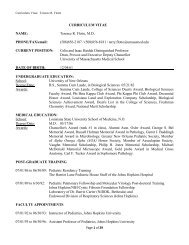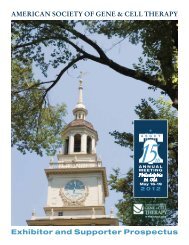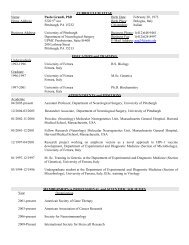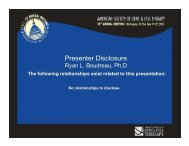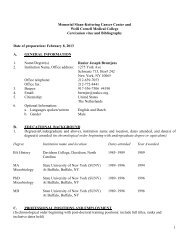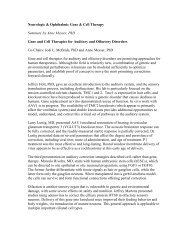Final Program - American Society of Gene & Cell Therapy
Final Program - American Society of Gene & Cell Therapy
Final Program - American Society of Gene & Cell Therapy
You also want an ePaper? Increase the reach of your titles
YUMPU automatically turns print PDFs into web optimized ePapers that Google loves.
<strong>Program</strong> Schedule, Friday, May 17, 2013<br />
PANEL<br />
Thomas W. Chalberg, Jr., PhD<br />
Artur Isaev, MD, MBA<br />
David Kirn, MD<br />
Sander van Deventer, MD, PhD<br />
Samuel C. Wadsworth, PhD<br />
Scientific Symposium 315<br />
9:45 am - 11:45 am<br />
ROOM: BALLROOM C<br />
Target Non Coding RNAs with Oligonucleotides<br />
CO-CHAIRS: Kevin V. Morris, PhD and Marco S. Weinberg, PhD<br />
SPEAKERS<br />
Claes Wahlestedt, MD, PhD<br />
RNA-Based Strategies To Upregulate <strong>Gene</strong> Expression<br />
Recently, key roles for regulatory long noncoding RNAs (lncRNAs) in the regulation <strong>of</strong> gene expression have emerged. I will review<br />
current understanding <strong>of</strong> the mechanisms <strong>of</strong> action <strong>of</strong> lncRNAs and their roles in disease, focusing on recent work in the design<br />
<strong>of</strong> inhibitors <strong>of</strong> the natural antisense transcript (NAT) class <strong>of</strong> lncRNAs, known as AntagoNAT oligonucleotides, and the issues<br />
associated with their therapeutic application.<br />
Christine Esau, PhD<br />
Targeting microRNAs in Human Disease: miR-33 in the Treatment <strong>of</strong> Atherosclerosis<br />
microRNAs are regulators <strong>of</strong> the genome that can modulate the activity <strong>of</strong> speciic gene networks. Single stranded oligonucleotides<br />
can be designed to inhibit the activity <strong>of</strong> individual microRNAs that are overexpressed in human disease. For example, miR-<br />
33 is a microRNA that is known to be overexpressed in macrophages that may be involved in the formation <strong>of</strong> atherosclerotic<br />
plaques. Inhibition <strong>of</strong> miR-33 has been shown de-repress known target mRNAs such as ABCA1, increase cholesterol eflux<br />
from macrophages and regress atherosclerotic lesions in rodent models. Thus targeting microRNAs holds great promise for the<br />
treatment <strong>of</strong> human diseases.<br />
Friday, May 17, 2013<br />
Keith Gagnon, PhD<br />
Long Noncoding RNAs Link Transcriptional Regulation <strong>of</strong> Inlammatory Pathway <strong>Gene</strong>s<br />
Coordinated expression <strong>of</strong> the eicosanoid signaling pathway genes COX-2 and PLA2G4A are regulated by a network <strong>of</strong> non-coding<br />
RNAs and gene looping. The long non-coding RNAs overlapping the COX-2 gene promoter can be targeted by complementary<br />
endogenous and synthetic small RNAs to elicit activation <strong>of</strong> both COX-2 and PLA2G4A transcription. This activation requires RNAi<br />
factors like Argonaute 2 and GW182, recruitment <strong>of</strong> RNA Polymerase II, and chromatin modifying factors. These indings suggest<br />
that non-coding RNA has the potential to assemble related genes into functional operons for regulation and small RNAs can control<br />
this mechanism to synchronously activate transcription.<br />
Kevin V. Morris, PhD<br />
Long non-coding RNAs, Epigenetics and <strong>Gene</strong> Expression<br />
In human cells some non-coding RNAs have been found to transcriptionally modulate gene expression by targeting epigenetic<br />
complexes to particular loci. The targeted disruption <strong>of</strong> these suppressor non-coding RNAs can result in targeted activation <strong>of</strong><br />
gene expression. Examples <strong>of</strong> this form <strong>of</strong> gene activation in disease models ranging from cystic ibrosis to HIV to cancer will be<br />
discussed.<br />
62<br />
<strong>Final</strong> <strong>Program</strong> SALT LAKE CITY, UTAH May 15–18, 2013



